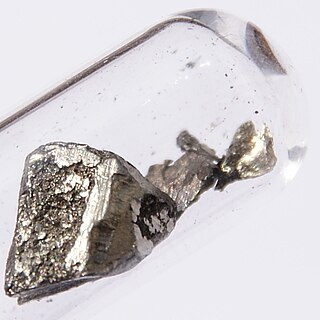Chemistry is the scientific study of the properties and behavior of matter. It is a physical science within the natural sciences that studies the chemical elements that make up matter and compounds made of atoms, molecules and ions: their composition, structure, properties, behavior and the changes they undergo during reactions with other substances. Chemistry also addresses the nature of chemical bonds in chemical compounds.

A chemist is a graduated scientist trained in the study of chemistry, or an officially enrolled student in the field. Chemists study the composition of matter and its properties. Chemists carefully describe the properties they study in terms of quantities, with detail on the level of molecules and their component atoms. Chemists carefully measure substance proportions, chemical reaction rates, and other chemical properties. In Commonwealth English, pharmacists are often called chemists.

Henry Gwyn Jeffreys Moseley was an English physicist, whose contribution to the science of physics was the justification from physical laws of the previous empirical and chemical concept of the atomic number. This stemmed from his development of Moseley's law in X-ray spectra.

Lanthanum is a chemical element with the symbol La and the atomic number 57. It is a soft, ductile, silvery-white metal that tarnishes slowly when exposed to air. It is the eponym of the lanthanide series, a group of 15 similar elements between lanthanum and lutetium in the periodic table, of which lanthanum is the first and the prototype. Lanthanum is traditionally counted among the rare earth elements. Like most other rare earth elements, its usual oxidation state is +3, although some compounds are known with an oxidation state of +2. Lanthanum has no biological role in humans but is used by some bacteria. It is not particularly toxic to humans but does show some antimicrobial activity.

The periodic table, also known as the periodic table of the elements, is an ordered arrangement of the chemical elements into rows ("periods") and columns ("groups"). It is an icon of chemistry and is widely used in physics and other sciences. It is a depiction of the periodic law, which states that when the elements are arranged in order of their atomic numbers an approximate recurrence of their properties is evident. The table is divided into four roughly rectangular areas called blocks. Elements in the same group tend to show similar chemical characteristics.

Primo Michele Levi was a Jewish-Italian chemist, partisan, writer, and Holocaust survivor. He was the author of several books, collections of short stories, essays, poems and one novel. His best-known works include If This Is a Man, his account of the year he spent as a prisoner in the Auschwitz concentration camp in Nazi-occupied Poland; and The Periodic Table (1975), a collection of mostly autobiographical short stories each named after a chemical element as it played a role in each story, which the Royal Institution named the best science book ever written.

A Belousov–Zhabotinsky reaction, or BZ reaction, is one of a class of reactions that serve as a classical example of non-equilibrium thermodynamics, resulting in the establishment of a nonlinear chemical oscillator. The only common element in these oscillators is the inclusion of bromine and an acid. The reactions are important to theoretical chemistry in that they show that chemical reactions do not have to be dominated by equilibrium thermodynamic behavior. These reactions are far from equilibrium and remain so for a significant length of time and evolve chaotically. In this sense, they provide an interesting chemical model of nonequilibrium biological phenomena; as such, mathematical models and simulations of the BZ reactions themselves are of theoretical interest, showing phenomenon as noise-induced order.

The periodic table is an arrangement of the chemical elements, structured by their atomic number, electron configuration and recurring chemical properties. In the basic form, elements are presented in order of increasing atomic number, in the reading sequence. Then, rows and columns are created by starting new rows and inserting blank cells, so that rows (periods) and columns (groups) show elements with recurring properties. For example, all elements in group (column) 18 are noble gases that are largely—though not completely—unreactive.

Julius Lothar Meyer was a German chemist. He was one of the pioneers in developing the earliest versions of the periodic table of the chemical elements. The Russian chemist Dmitri Mendeleev and he had both worked with Robert Bunsen. Meyer never used his first given name and was known throughout his life simply as Lothar Meyer.

Carl Gustaf Mosander was a Swedish chemist. He discovered the rare earth elements lanthanum, erbium and terbium.

Baron Axel Fredrik Cronstedt was a Swedish mineralogist and chemist who discovered the element nickel in 1751 as a mining expert with the Bureau of Mines. Cronstedt is considered a founder of modern mineralogy, for introducing the blowpipe as a tool for mineralogists, and for proposing that the mineral kingdom be organized on the basis of chemical analysis in his book Försök til mineralogie, eller mineral-rikets upställning.

John Drury Clark, Ph.D. was an American rocket fuel developer, chemist, and science fiction writer. He was instrumental in the revival of interest in Robert E. Howard's Conan stories and influenced the writing careers of L. Sprague de Camp, Fletcher Pratt, and other authors.

Carl Axel Arrhenius was a Swedish military officer, amateur geologist, and chemist. He is best known for his discovery of the mineral ytterbite in 1787.

Baron Jöns Jacob Berzelius was a Swedish chemist. In general, he is considered the last person to know the whole field of chemistry. Berzelius is considered, along with Robert Boyle, John Dalton, and Antoine Lavoisier, to be one of the founders of modern chemistry. Berzelius became a member of the Royal Swedish Academy of Sciences in 1808 and served from 1818 as its principal functionary. He is known in Sweden as the "Father of Swedish Chemistry". During his lifetime he did not customarily use his first given name, and was universally known simply as Jacob Berzelius.

Cerium is a chemical element; it has symbol Ce and atomic number 58. It is a soft, ductile, and silvery-white metal that tarnishes when exposed to air. Cerium is the second element in the lanthanide series, and while it often shows the oxidation state of +3 characteristic of the series, it also has a stable +4 state that does not oxidize water. It is considered one of the rare-earth elements. Cerium has no known biological role in humans but is not particularly toxic, except with intense or continued exposure.
In chemistry and physics, the iron group refers to elements that are in some way related to iron; mostly in period (row) 4 of the periodic table. The term has different meanings in different contexts.

James Curtis Booth was an American chemist who was the melter and refiner at the United States Mint in Philadelphia for many years.
GFS Chemicals Inc, formerly known as G. Frederick Smith Chemical Company, is a privately owned fine and specialty chemical company with headquarters in Powell, Ohio and manufacturing facilities in Columbus, Ohio. It was founded by G. Frederick Smith in Urbana, Illinois in 1924, and moved to Columbus, Ohio in 1928.

Clarice Evone Phelps (née Salone) is an American nuclear chemist researching the processing of radioactive transuranic elements at the US Department of Energy's Oak Ridge National Laboratory (ORNL). She was part of ORNL's team that collaborated with the Joint Institute for Nuclear Research to discover tennessine. The International Union of Pure and Applied Chemistry (IUPAC) recognizes her as the first African-American woman to be involved with the discovery of a chemical element.

















